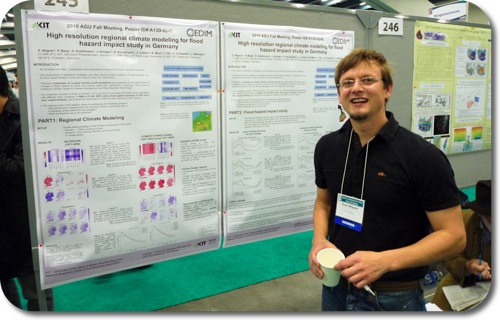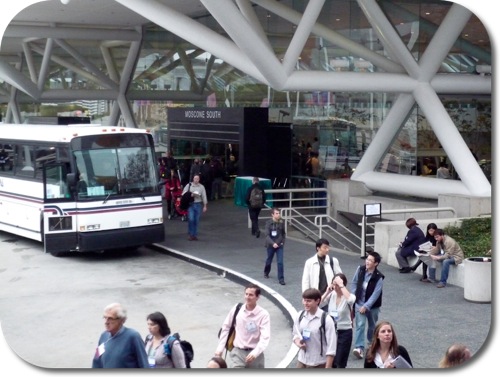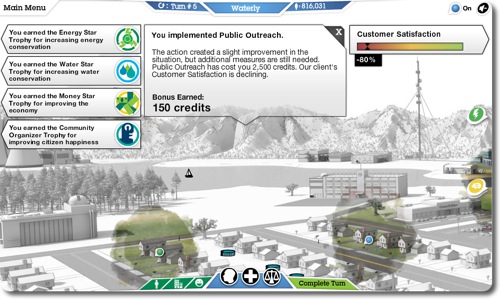Archive for 2010
Identi.ca Weekly Updates for 2010-12-29
- super awesome time-lapse of snow accumulation during storm http://bit.ly/eB1ElJ (h/t @DaveMosher and @mattdanzico ) (via @clasticdetritus) #
Identi.ca Weekly Updates for 2010-12-15
- @seismotom sorry, I was travelling, missed your tweet. Are you at the social media soiree tonight? in reply to seismotom #
- Off I go to #AGU10 tomorrow! Talk on Thu, 12:05pm in MW-3018: non-Gaussian K fields and macrodispersion. Can't wait to see fellow tweeters! #
- Hey @seismotom – I'd be up for #python beers anytime! in reply to seismotom #
- Movie with Hans Rosling: The #joy of #statistics http://ke-we.net/9cd. Full show at BBC: http://ke-we.net/9ce. How can I watch in Germany? #
AGU Fall Meeting 2010 – Day 2
It’s only the second day, and yet I am starting to feel it! 😉 It is quite easy to identify the highlight of the day: Bill Gray’s talk – the Langbein lecture. But after that? An awesome discussion around a poster. Some ok precipitation downscaling talks. A good talk by Ty Ferre on hydrogeophysics.
So what did Bill Gray have to say? Of course he gave a very precise introduction into the methodology he developed for upscaling by the thermodynamically constrained averaging theory (TCAT). In addition he made sure to get another point across: the challenges involved in attempting to establish a novel scientific methodology.
In his early career, Gray was actively involved in the change from finite difference methods to finite element methods. Finite elements are superior and it took quite some time and some work until the majority had accepted that finite elements are better. Bill Gray generalized based on this example: according to him most innovations need time and a lot of work by the people behind those new ideas, until they are established. He admitted that obviously not everything new will or can turn later into an established method. But at the same time he appealed to editors of journals to be very careful, and not dismiss something at first sight. Even if a proposed novel method seems to act against whatever current “state of the art” might be.
AGU Fall Meeting 2010 – Let the Show Begin
From Stuttgart via Zurich we made it to San Francisco. San Francisco greeted us with spectacular colours on the sky during sunset. There’s more people here than last year, now up to about 19 000 people!

Sven at his poster

Moscone South on the morning of the first day at AGU 2010
Here are three take-home points from day one (more detailed notes in opml here)
- very nice poster session in the morning! Geophysics and hydraulic conductivity, Mariotte bottle with a twist;
- I learned in the lecture by Charles C. Eriksen about the state of the art of measuring in the oceans;
- slightly disappointed by presentation sessions in the afternoon
- great talk by Julia Slingo, scientific director of the UK Met Office on “Society’s Growing Vulnerability to Natural Hazards and Implications for Geophysics Research”. Favourite quote on the volcano-eruption in iceland:
we haven’t done a full risk assessment, because we have never looked at the effects that unfavourable weather conditions might have on a not so unusual eruption.
- great social media soiree with lots of enthusiastic folks! Great inspiration!
Identi.ca Weekly Updates for 2010-12-08
- @kwerfeldein ne, mit "lightbox" in der URL schaut's so aus http://twitpic.com/3dpri3 in reply to kwerfeldein #
- @kwerfeldein: Hilfe! warum steht in Deinen FlickR URLs am Ende of /lightbox/? Dann sehe ich nie direkt das Bild…nur wenn ich's lösche? in reply to kwerfeldein #
- #media makes headline of serious interview on #climate #change to "Coldest Winter in 1000 Years" – many copy blindly: http://ke-we.net/92l #
- The Guardian has a “water hub” http://ke-we.net/8xy #
- #Geology of Europe for non-Geologists (ebook): http://ke-we.net/8xv#/ #
- #Lead unsolved problem for #drinking #water since roman times. The world is heterogeneous! http://ke-we.net/8xt #
- Dalai Lama on #Tibetean Plateau: #climatechange – #Glaciers melt 3x faster than elsewhere: http://su.pr/16uav5 (via @circleofblue) #
- Hydrogeologists Without Borders has a new website! Check it out: http://www.hwbwater.org (via @WaterWired) #
World Days
Sorry folks, I missed the
- Geography Awareness Week: “Freshwater” (Nov 14 – 20), which included GIS Day
- Africa Water Week (Nov 22 – 26)
- World Toilet Day (Nov 19)
This made me think a little. How many “special” days are there?
- Here is a list of UN days
- here are some more days
- general holidays are listed at when-is.com
However, there seems to be an endless list of “special” days. Worldwaterday, WorldMathsDay, WorldBookDay, … What’s the point?
Experience with IBM’s City One Game
IBM has recently launched an online game called “City One“. It was heralded to be similar to SimCity. You are something like the major of a city, and you have to “make decisions” in four sectors energy, water, retail, and banking.
Unfortunately, I found CityOne to be a worse game than SimCity. The decisions you make are in fact not real decisions. For each of the sectors you have an “expert”, who gives you three options. I never found that your decision has a major negative impact on the overall status of your city. In fact, all of the offered solutions sort of make sense. Sometimes it even seems like the proposed solutions could be out of a consultant’s (IBM?) catalogue. For somebody who has never thought about what a measure could be that could lead to less water losses in a distribution system, this game might be better suited for.

IBM's 'City One' game. I just earned a bunch of bonuses.
Some of the proposed solutions are more expensive than others, your funds are limited. However, the game is played in rounds, and in each round your funds recover. After the default 10 rounds my city’s status has been very positive, I had a score of 97,700. It remained unclear when the game is over, I could have continued to play.
Software tools of the trade (PhD student)
A joiner likes to talk about his saws. Similarly, Phd students need to use some “tools of the trade”. Recently, some improvements on old tools emerged, and some new guys showed up on the scene. I thought these are worth pointing out. Mostly, these tools don’t offer incredible novel features. Rather, they offer slight improvements which on a daily basis offer nice benefits
Scrivener 2.0
As I see it, the new scrivener is a great tool to – organize thoughts; – collect data / “research” — it even has some features I wish DEVONthink Pro would have; – Write — I am writing this post in scrivener. However, I still haven’t found an ideal solution, hence I still write most of what I write in latex or markdown using TextMate. So far, I have even written all blog posts using TextMate (I am aware of MarsEdit, but I haven’t tried it yet). The thing is, for scientific writing, I don’t see an option to latex. And TextMate is probably as good as a latex editor in the foreseeable future will get.
I see scrivener’s strong points especially for writing combined with organization. It has some really nice features like split panes, internal links, or how it handles comments. But it does not cover my most important needs for scientific writing (even though there are some workarounds (here and here) via markdown, but they remain workarounds. Also for organization, DEVONthink Pro is still superior in my opinion. I haven’t tried the new Yojimbo. Also, there is the classic outliner OmniOutliner which together with OO3eq offers basic latex capabilities.
To conclude, I use a combination of DevonThink, Scrivener, and Textmate for blogging, OmniOutliner for writing notes in courses and meetings, and TextMate for scientific writing. It sure would be nice to have one for all. But isn’t that always the problem?
Pinboard
A common complaint is that Yahoo never gave delicious.com much love. Delicious.com is an online bookmark storage/sharing tool. Recently, pinboard showed up. It’s fast, it can be nicely integrated into Safari, and it has some nice features like “read later”.
Mendeley
As a PhD student, I need to read scientific papers. And since there are many, I need a way to store and find them. Also, I need to reference them when writing a scientific article. So far, I’ve been fairly happy with BibDesk‘s capabilities, especially, it’s easy link to writing latex documents in TextMate and its ability to automatically store pdfs. A factor that counts pro BibDesk is that BibDesk is open source software.
I’m aware that the functionality for reading and commenting in Papers is supposed to be improved compared to BibDesk. Recently Mendeley showed up on the scene. It’s an approach to social-web-style-reference management funded by Skype, last.fm, and Warner Music. You have to sign up, and the basic version is free and comes with 500MB personal space and 500MB shared space.
Mendeley is still pre v.1.0, and I had and still have issues importing my bibtex library into Mendeley. The interesting part is that you can look for people with similar research interests, say statistics in earth sciences, and see what those people are reading. Also, Mendeley has a public API, so programmers can access research paper statistics, for example. It will be interesting to see what will be created with these options.
MS Office 2011 for Mac
Since MS Word 6.0 is gone, my positive feelings for Word and its office suite have disappeared. However, sometimes it’s not possible to avoid it, especially since at work we’re using Excel to teach students. And granted, excel is pretty intuitive. Recently, a new version for the Mac came out, and some of those long-lost positive feelings have re-surfaced.
- the biggest plus: it finally is fully integrated into OSX 64bit. Hence, general performance is improved.
- Excel: the formula bar is back to a fixed location! Yay!
- Word has a distractive-free writing mode, similar to writeroom, think!, or the even more general solution – because it provides a distraction-free environment for any application isolator
- VBA is back – not that this is huge, but it sometimes helps in labs that I teach
- Excel: some improvements to charting, but I bet it’s still the same old charting engine from the last millenium
- The solver is again VBA-based and hence better “includeable” into excel
Identi.ca Weekly Updates for 2010-12-01
- at #IAHR BW annual colloquium: http://ke-we.net/8gp #water #climate #change #
Converting Pictures (png) to a Movie (avi)
I just had the problem to convert a fairly big number of png files into a movie. It turns out, the solution on a mac is fairly easy.
convert the png’s to jpg. This step seems necessary — I couldn’t get the movie to work with png’s. I’ve done it under OSX comfortably with a fairly simple automator workflow:
- get specified finder items
- copy finder items
- change type of images
- make finder item names sequential
download and install mencoder. All I ended up doing is downloading these two executable files and copying them into /usr/bin
- the all you need to do is go into the directory where your jpgs are and execute
mencoder "mf://*.jpg" -o movie.avi -ovc lavc -lavcopts vcodec=mjpeg
The original suggestion I found here. Some more suggestions here. I played a bit with the framerate -ofps (see manpages). Here’s the wikipedia page. Here’s a video encoding wiki.
update Monday; June 24, 2013: scaling, cropping and compression can work like this
mencoder -oac copy -ovc xvid -xvidencopts pass=2:bitrate=-700000 -vf scale=480:-2,crop=480:208